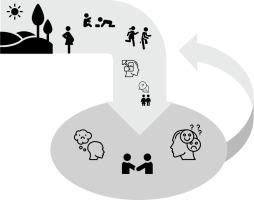Environment International ( IF 11.8 ) Pub Date : 2020-11-12 , DOI: 10.1016/j.envint.2020.106238 Lærke Mygind , Mette Kurtzhals , Clare Nowell , Paulina S. Melby , Matt P. Stevenson , Mark Nieuwenhuijsen , Jarrad A.G. Lum , Trine Flensborg-Madsen , Peter Bentsen , Peter G. Enticott

|
Background
Existing research indicates that spending time in nature is associated with diverse aspects of children’s health and wellbeing. Although fundamental to later life chances and health, no systematic reviews, to our knowledge, have focused specifically on the effects of interaction with nature on socioemotional functioning in childhood.
Objectives
Amongst children, what is the consistency of associations between the availability of or spending time in nature on socioemotional function and development? Furthermore, which child behaviours and states independently associate with socioemotional function and availability of or spending time in nature, and what is the consistency of associations between these behaviours and states and contact with nature?
Data sources
Embase, Environment Complete, MEDLINE, and APA PsycINFO. Eligible studies were backward and forward snowball-searched.
Study eligibility criteria
Studies investigating effects of, or associations between, availability of or interaction with nature on socioemotional or proximal outcomes in children under the age of 12 years were included in this review.
Study appraisal and synthesis methods
The internal validity of studies investigating socioemotional outcomes were based on assessments of elements of study design, conduct, and reporting to identify potential issues related to confounding or other biases. The number of analyses indicating positive, negative, and non-significant associations between availability or interaction with green space and the outcomes were summed.
Results
A total of 223 eligible full-texts, of which 43 pertained to socioemotional outcomes and 180 to proximal outcomes, met eligibility criteria. Positive associations between availability of and spending time in green space were found with children’s intra- and interpersonal socioemotional function and development. Proportions of positive findings ranged from 13.9% to 55% across experimental and observational research, exposures, populations, and contexts. Modifying and mediating factors were identified.
We found consistent evidence for improved aspects of cognition and, for children over six years, reduced risk of obesity and overweight in association with green space; consistent links between movement behaviours in the experimental, but not observational research; tentative trends suggesting associations with play, motor skills, language, screen time, and communication skills; little evidence for positive associations between green space and mood, physical wellbeing, and stress; some evidence for associations with healthy birth outcomes, and little evidence for direct associations between availability of green space and asthma and allergy prevalence, however, mediation via, for example, air pollution was likely.
Limitations
We identified few studies without either probable or severe risk of bias in at least one item. Improved study quality may therefore result in different results. Restricting analyses to include only studies considered at low risk of bias indicated similar or slightly lower proportions of positive findings. Risk of bias in proximal outcomes was not assessed.
Conclusions
The empirical evidence for benefits of availability of and interaction green space for child socioemotional function and development must currently be considered limited. A number of proximal indicators were identified.
Systematic review registration number. PROSPERO ID: CRD42019135016.
中文翻译:

成为社会的风景:系统地审查儿童与自然互动和社会情感发展之间的关联和途径的证据
背景
现有研究表明,在大自然中度过的时间与儿童健康和福祉的各个方面相关。虽然对于以后的生活机会和健康至关重要,但据我们所知,没有系统的评论专门关注与自然互动对儿童社会情感功能的影响。
目标
在儿童中,自然界中可利用的时间或社会情感功能与发展之间的联系的一致性是什么?此外,哪些儿童行为和状态独立地与社会情感功能和自然的可用性或消磨时间相关联,这些行为和状态与自然界的联系之间的一致性是什么?
数据源
Embase,环境完善,MEDLINE和APA PsycINFO。符合条件的研究是向前和向后滚雪球搜索的。
研究资格标准
本研究包括调查自然的可用性或相互作用与12岁以下儿童的社会情感或近端结局的影响或相关性的研究。
学习评估和综合方法
研究社会情绪结果的研究的内部有效性基于对研究设计,行为和报告要素的评估,以识别与混淆或其他偏见相关的潜在问题。汇总了表明可用性或与绿地的交互作用与结果之间的正,负和不重要关联的分析次数。
结果
符合资格标准的共有223篇符合条件的全文,其中43篇涉及社会情感结局,180篇涉及近端结局。人们发现,绿色空间的可利用性和消遣时间与儿童的人际和人际社会情感功能与发育之间存在正相关关系。在实验和观察性研究,暴露,人群和背景下,阳性结果的比例从13.9%到55%不等。确定了修改和调解因素。
我们发现一致的证据可以改善认知方面,对于6岁以上的儿童,与绿色空间相关的肥胖和超重风险降低;在实验而非观察研究中,运动行为之间始终保持联系;暂时的趋势表明与游戏,运动技能,语言,上映时间和沟通技巧之间的关联;几乎没有证据表明绿色空间与情绪,身体健康和压力之间存在正相关关系;有一些证据表明其与健康的出生结局有关,而很少有证据表明绿色空间和哮喘的可获得性与过敏发生率之间存在直接的关联,但是,通过空气污染等进行调解的可能性很高。
局限性
我们发现至少有一项研究没有偏倚的可能或严重偏倚风险的研究。因此,提高研究质量可能会导致不同的结果。将分析限制为仅包括被认为具有低偏倚风险的研究,表明阳性结果的比例相似或稍低。未评估近端预后偏倚的风险。
结论
当前必须考虑到为儿童的社会情感功能和发展提供和互动绿色空间的好处的经验证据。确定了许多近端指标。
系统的审查注册号。订单编号:CRD42019135016。



























 京公网安备 11010802027423号
京公网安备 11010802027423号